Environment and climate
What are the ideal locations for wind turbines in Austria? GeoSphere Austria wants to answer this question with the help of artificial intelligence (AI). Wind fields should be calculated and recommendations for the installation of future wind farms made available to politicians.
GeoSphere Austria (formerly the Central Institute of Meteorology and Geodynamics – ZAMG) is working on several research projects on wind turbines with artificial intelligence. Using “AI4Wind” (note: AI stands for “artificial intelligence”) and “Wind4Future”, spatio-temporal high-resolution wind fields at different altitudes are calculated in order to take into account different types of turbines.
In addition, a document is being prepared that includes specific recommendations for policy makers regarding the establishment of wind farms in the future. Anne-Marie Lexer, wind project coordinator at GeoSphere, says the use of artificial intelligence plays an important role in both projects. According to GeoSphere, wind direction and strength can vary greatly even within small sized areas. Wind measurements from weather stations do not represent the environment.

According to the research institute, there are hardly any direct measurements of air layers up to a few hundred meters above the Earth’s surface—necessary for wind turbines. For these values, measurements from weather stations will be converted to the surrounding terrain. This is happening more and more with AI methods such as machine learning, where these complex relationships are built into very large amounts of data.
Wind turbines by state
NE: 762
Burgenland: 445
Styria: 114
Upper Austria: 31
Carinthia: tenth
Vienna: 9
Vorarlberg, Tyrol, Salzburg: 0
Source: IG Windcraft
Artificial intelligence recreates the “behaviour” of wind fields
“Simply put, when using AI, programs learn to recognize connections from past data and apply them to new situations and environments,” says Irene Sheker, an AI expert at GeoSphere. “In the case of winds, for example, it is about learning from previous measurements how wind direction and wind strength at a given measurement point relate to the wind field in the surrounding area.” In the GeoSphere project, vertical wind fields would be between ten and 350 meters counted.
Projects with AI calculations will solve the problem of previous studies. According to GeoSphere, this will not allow an assessment of the effects of climate change on wind and the consequences of wind power generation. Both projects will run until 2025. Two wind farm operators in Lower Austria are also involved: WEB Windenergie AG based in Pfaffenschlag near Waidhofen an der Thaya and Windkraft Simonsfeld AG based in Ernstbrunn (Korneuburg district).

“Total coffee aficionado. Travel buff. Music ninja. Bacon nerd. Beeraholic.”








More Stories
Wealthy families take more risks when it comes to money.
Salesforce and NVIDIA Form Strategic Collaboration to Drive AI Customer Innovation
Changing banks causes problems for customers